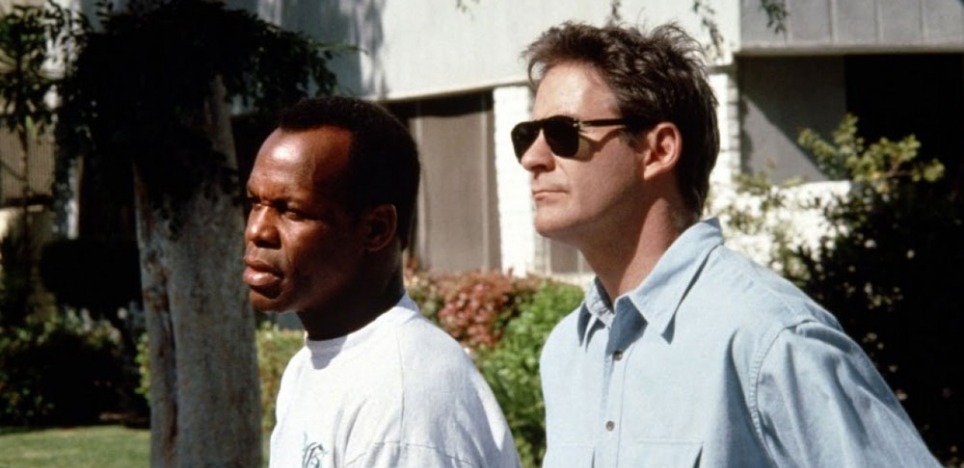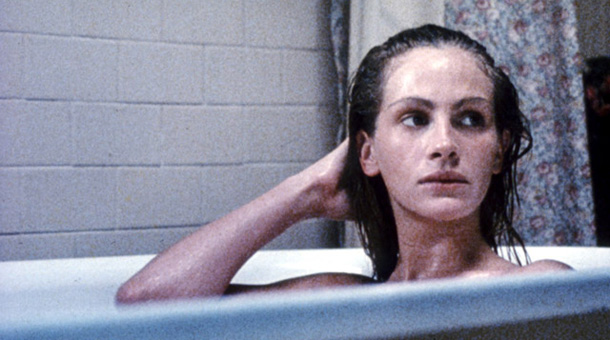
[Another supplemental choice – I picked this one because,
although not a hit, it was a critical darling, and certainly a film I’ve
thought much of since I first saw it all those years ago…]
Although he didn’t know it yet, Lawrence Kasdan, in 1991,
began a subgenre. His Grand Canyon, which
he wrote and directed, alongside Steve Martin’s L.A. Story earlier that year, sought out to explore the frailty of
life, ad how the random ways we interact with each other, often as strangers,
are sometimes only the things that can offer us salvation, physically,
psychologically and spiritually. It’s no accident the films of this ilk take
place in Los Angeles – the home of most of these filmmakers but also a
discordant brew of various races, ethnicities and generations in which harmony
does not always come easy. Later films, like Short Cuts, Magnolia and Crash
continued up this theme – all feature ensemble casts, too, showing us those
lives that bounce around the room, and somehow give us the meaning to it all we
so desperately lack in solitude.
But I think it all started with Grand Canyon, and it’s a worthy progenitor. It doesn’t have the
distinctive style of an Altman or an Anderson, but it’s got a style nonetheless
– a glassy, straightforward and often jarring timepiece of he early 90s, with
B&W basketball scenes for the opening credits and a synth-beat score that
gives the film just the dreamy ether it needs for such an examination. But,
more importantly, it depicts a group of people just on the verge of a
shattering chasm – the 80s just recently ended, a few months before the L.A.
riots, nine years before the new millennium and and ten before 9/11, it so
perfectly depicts the collective anxiety of
America culture on the precipice. Sure, it’s L.A., but it could happen here, or
there. We all feel it coming.
But yet, Grand Canyon is
a hopeful film. Its players all yearn to find fulfillment in one way or anther,
despite the likelihood that, as the Danny Glover character puts it, “we’ll all
have at least a few truly terrible things happen to us in our lifetimes.” He oughta
know – as Simon, a tow-trucker driver in the bad part of town, he’s got a
thankless beat. But one night, he must give a lift to an upper-class
immigration lawyer named Mack, lost and broken down, and about to be mugged –
or worse – by a street gang. The two start up a friendship, and Mack, vowing
not to let a savior’s good deed go unrewarded, buys Simon breakfast, sets him
up with a date with a woman named Jane (Alfre Woodard), and arranges a
better-located apartment for his sister and her family, currently struggling in
a crime-riddled neighborhood.
Perhaps Mack’s benevolence has something to do with the
uncertainty of his own life. His wife, Claire (Mary McDonnell), while jogging,
had discovered an abandoned baby, and now wants to adopt it, possibly relating
to the anxiety of her upcoming empty-nest syndrome. Their marriage may be on
the rocks as well; Mack had an affair with a co-worker named Dee (Mary
Louise-Parker), and her story is told too – through the tears of a young woman
who just wants love, and knows she will never get it out of infidelity. And
last we have Davis (Steve Martin), a violent-action movie producer (based on
Joel Silver, of Die Hard and Letha Weapon), who, who after getting
shot in the leg by a robber, gets an epiphany – no more glorification of blood.
No matter that his change is to be short-lived; he’s changed nonetheless, as is
everyone in this story. In he end, Simon takes them all on a trip to the Grand
Canyon, as a measure of their own insignificance in the grand scheme of things.
Kasdan, of course, is mining the same territory that he did
with his 1983 masterpiece The Big Chill –
coming to grips with one’s own mortality while at the same time relying on
each other to make sense of it all. Chill
was a work clearly borne of the director’s post-collegiate existentialist dillema,
and his antipathy with those outside his generation who couldn’t understand
what all the “love-in” nonsense was all about. It was a loving picture, as
loving as the people who inhabited it, about a pack of baby-boomers who get
together after the suicide of a colleague, and, although each of them have
individualized feelings, it’s soundly structured around that weekend together –
on a crisp, fall day, when the sanctity of their sanctum is all that makes
sense.
Canyon is sort of
a follow-up – it’s characters don’t all share the same graduation date but
they’re all experiencing the same ennui. But the film lacks the focus of Chill; it doesn’t have that anchoring
timeframe; rather, it circulates in and out of the characters’ lives like a
new-age music video, and we’re sort of left to find a connecting thread. It’s not
terribly difficult, and to make our lives easier Kasdan uses the symbol of the
Grand Canyon, quite literally, to rope it all together (like Altman did with
the earthquake and Anderson did with the frogs). In the end, we feel beaten up
by the black strife and the gang warfare and the shooting and Mack’s cut
finger, but we somehow feel an affinity with these characters because they’re
all talking about their experiences, as
if we’re a fly on the wall of their therapy sessions. And that’s what
ultimately lifts Canyon above and
beyond others of its kind.
This is nothing to sneeze at, either – how often do you hear
discourse about the infinitesimalness of life in a major studio picture? Never,
I’ll bet, but Kasdan wisely cloaks it as a social satire of modern L.A. life.
Yes, it is that, but it’s so much more. Watch the film, and glean for yourself
its messages. (I found it enormously ahead of its time in its chronicle of race
relations; far superior to the later, heavy-handed Crash). That’s because I applaud its “we’re all in this together”
bottom line. When Kevin Kline and Danny Glover share a beer, not as blacks or
whites but as people, I was gladdened. I had a similar conversation with a
black man not too long ago. We didn’t talk about racial differences – we talked
about life. And maybe that’s what we all need to start doing.
Grand Canyon has
some intense moments – too intense perhaps – and some of it is a bit indulgent
(Kevin Kline flying over L.A.? to spy on his mistress?). But on balance I
admired the reach of this film. It’s a film of ideas.
And we just don’t get that too often.
Rating: ****





